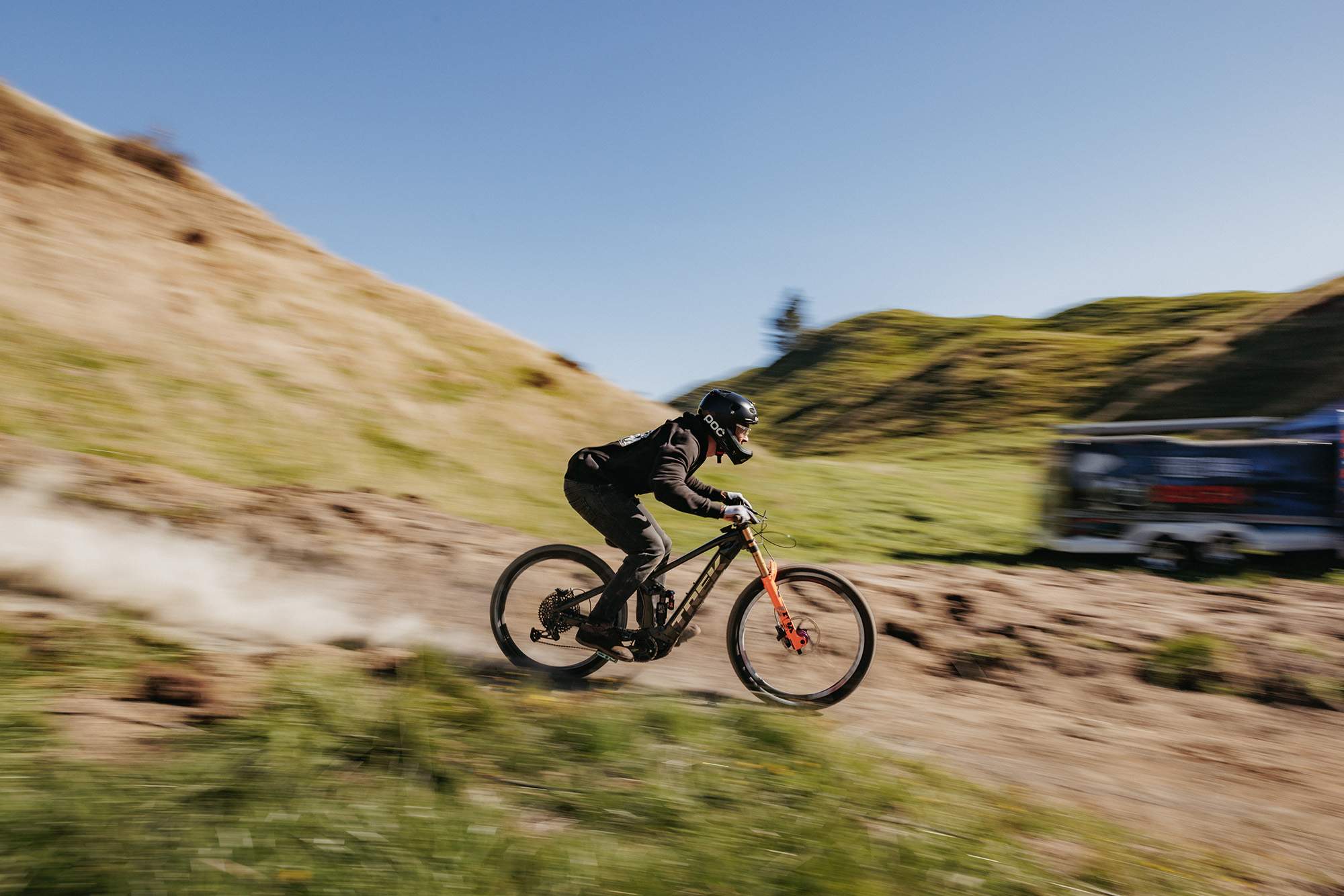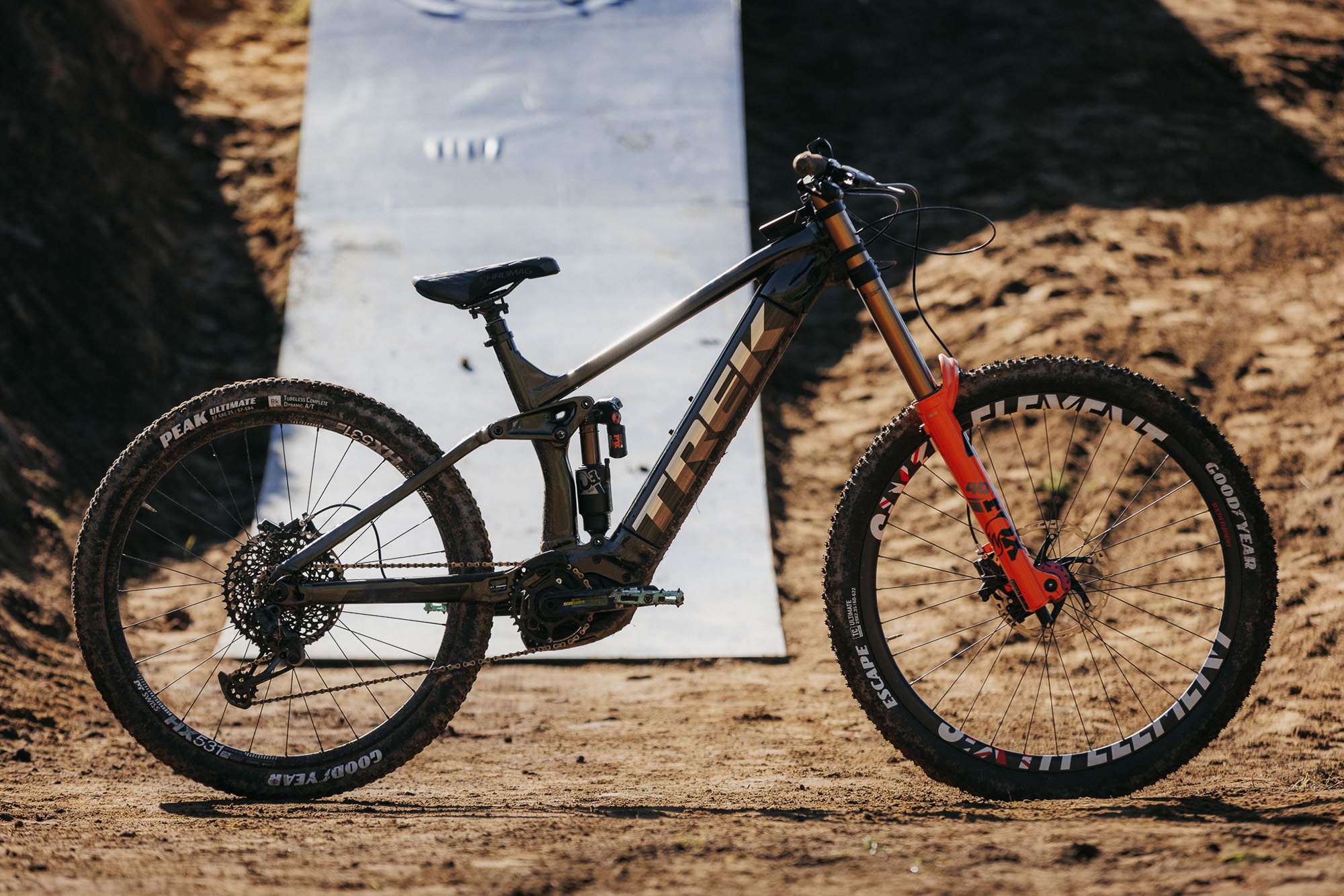Jed Mildon recently smashed the e-Bike long jump world record sailing a massive 24.37 metres aboard his custom Trek Rail 9 equipped with a powerful Bosch motor, battery, and head unit.
You can check that out here, but to learn more about how Jed’s bike set-up we recently caught up with his mechanic Jono Church from Suspension Lab, who was tasked with prepping the bike especially for the (successful) record attempt.
Words // Malcolm Wilson
[E]: To start with talk us through the major challenges you faced in taking an off-the-shelf Trek Rail 9 designed for trail riding and turning it into a bike capable of jumping and safely landing massive jumps?
It was one of the more interesting jobs I’ve had, but the toughest parts were probably the less exciting things! Supply chain issues were at their peak late last year, so finding parts that would work together, handle the task, and stay on budget was a tricky balancing act.
The Rail is one of the more challenging bikes to find a replacement shock for, even on a good day, since the large down tube (for housing the battery) severely limits shock clearance. The majority of my go-to recommendations weren’t even close to fitting because the external reservoir would contact the down tube at bottom out.
This bike would DEFINITELY be reaching bottom out, so there needed to be plenty of clearance plus some healthy margin to allow for things like twisting and flex under load.
Jed was also keen to run a downhill fork and I agreed that would be the sturdiest configuration for those harsh landings, but, again, availability was super limited. I had a long travel single crown on standby until I could get my hands on the dual crown Marzocchi 58. Again, the frame wasn’t really designed around a DH fork, so things like the lower headset bearing being recessed and the size of the headtube/downtube meant I had to find the right headset configuration to stop the lower crown from smashing into the frame. The wheels needed replacing with stronger rims and spokes, as well as changing to 27.5” to suit the Marzocchi fork. We had considered 29” wheels would help with rolling speed, but the fork availability was non-existent plus there would be even more risk of tyre /downtube contact. Moving to 27.5” wheels meant I could get a whole package that worked, the geometry would stay fairly consistent, and I knew there was plenty of room.
The biggest thing was changing out the fork and shock to something designed for big jumps and harsh landings.
[E]: What modifications did you end up making and why?
The stock rear shock was pretty limited with its adjustability and capability but like I said earlier there aren’t many alternatives that fit! I tracked down a previous generation Fox Float X2 which does fit because of its smaller piggyback. I then fully rebuilt it with the hardest tune in Fox’s catalogue, then ran it on my dyno to make sure the damping rate was appropriate for the task. It worked out great and I was able to set the adjusters where it had plenty of compression and rebound control but also some room to tweak things either way.
The dual crown fork was pretty important for surviving harsh landings, but it needed some adaptor plates to stop the lower crown bottoming on the head tube. I changed the compression valving to something with more control, as well as firmer rebound valving to match the high spring force Jed would be using.
The Marzocchi fork needed 27.5” wheels so I built a pair of wheels using the sturdiest rims available from the DT Swiss alloy eMTB range. These needed to be strong, obviously, but also wide enough to support the tyre properly on landing. Wheels are the kind of thing that won’t necessarily gain any distance but could end a jump attempt if they broke!
[E]: Once the jumping started some further modifications were made, why was this and what did you learn once Jed started testing at the ‘record’ jump site?
Jed was getting some good run-in speed but not quite enough to get the distance he was aiming for. Some of the factors like what speed he would need had been a bit unknown before that point, or how the bike would hold up to repeated jumps.
Jed wanted to try a 29” front wheel to increase speed and I suggested a slightly wider tyre at the same time, since it would roll faster on the dirt run in. I arranged to borrow a wheel from Matt, one of my sponsored riders, who happily lent us one as well as his own Fox DH fork when we found the rotor spacing of his wheel wouldn’t fit. Luckily it was almost identical to the one Jed had, and I had already prepped it for Matt. He was even generous enough to swap it all over late in the evening before the record attempt!
 [E]: We’ve heard that Jed wants to have another crack and thinks he can jump even further. What did you learn and are you going to make any more changes to the set-up?
[E]: We’ve heard that Jed wants to have another crack and thinks he can jump even further. What did you learn and are you going to make any more changes to the set-up?
The suspension held up great, but he needs more speed so I’m keen to find ways to cut down as much drag as possible. There wasn’t really enough time to optimise tyre choice, so I’m planning to spend some time working on that to find the ideal width and tread and the right pressure for the conditions. Having now completed some successful jumps we know the Goodyear tyres worked well so I can refine from there.
Aerodynamics also become a huge factor at those speeds, and while it hasn’t been studied much in mainstream mountain bikes, it’s an area I’ve been really interested in for the last few years. Even if Jed can do things like wearing a size smaller jersey, could be a really big gain.
The only real mechanical issue was the headset bearing breaking, which was relatively minor considering the scale of this jump. I would still like to prevent that one from happening again, because the ideal scenario would be Jed doesn’t have to think about the bike on the day, and can just focus on getting that distance.
[E]: When you’re jumping 80ft long and over 20ft high on an eBike, suspension is going to play a BIG part in the set-up. How did you set up the suspension specifically for Jed?
Super firm, obviously, but that doesn’t necessarily mean maxing out the air pressures and volume spacers. The front and rear suspension needed to be balanced to give a stable platform during the run in and on landing.
The compression damping was crucial to absorb the impact energy of the jump. One of the biggest dangers for freeriders is getting bucked after landing, which is often mistaken for a rebound problem. In reality, the shock hasn’t damped (“soaked up”) enough force during compression, so it gets transferred to the frame then unloaded all at once back at the rider.
[E]: You have an increasing number of eBikes through Suspension Lab for custom suspension tuning. What did you learn from this project that you can apply to everyday riding applications on eBikes, if anything?
It was impressive to see how well everything stood up to the jump. At the end of the day the bike is built with 100% off-the-shelf parts including the original drivetrain, so (in the right hands at least) you can be pretty confident of how much aggressive riding it can take. eMTBs used to have a reputation for being awkward and heavy, so I can now point to what Jed’s done as evidence that is definitely not true.
 Bike Build
Bike Build
Frame: Trek Rail 9
Frame size: Large
Motor: Bosch Performance Line CX, smart system, magnesium motor body, 85 Nm, 32 km/h max assist
Controller: Bosch Kiox 300, smart system
Battery size: Bosch PowerTube 750 Wh, smart system
Rear Suspension: Fox Float X2, custom tuned by Suspension Lab
Firm / stiff – Rebuilt to be as firm as possible with specs, compression & rebound in the mid-range
Front Suspension: Fox 40 with Vorsprung Secus Air Spring Upgrade Kit
Firm / stiff – fast / slow? Also firm to balance out the back end, compression & rebound in the mid-range
Wheelset: Front, Sixth Element Classic 29″ Carbon / Rear, DT Swiss HX531 27.5″ Alloy EMTB specific rim
Tyres: Front, Goodyear Escape Ultimate 29 x 2.35 / Rear, Goodyear Peak Ultimate 29 x 2.25 – both set up tubeless
Tyre pressures: 40 – 45 PSI
Brakes: SRAM Code R
Rotors: SRAM Centreline 200mm front / 180mm back
Handlebars: Giant Contact Carbon 780mm x 35mm
Stem: Deity Intake Direct Mount Black Edition 50mm with 35mm clamp
Headset: Knock Block Integrated, 58-degree radius, cartridge bearing, 1-1/8″ top, 1.5″ bottom upgraded with Enduro Bearings note: this took a lot of the load on landing
Grips: Deity
Shifters: SRAM GX Eagle, 12-speed
Crankset: SRAM GX
Front ring size: 34 tooth
Chain: SRAM GX Eagle, 12-speed
Cassette: SRAM Eagle XG-1275, 10-52, 12-speed
Rear Mech: SRAM GX Eagle
Pedals: Deity Deftrap – Turquoise
Seatpost: Bontrager Line Elite Dropper, 170 mm travel, MaxFlow, internal routing, 31.6 mm, 480 mm length – slammed way down low!
Saddle: Cromag Overture










